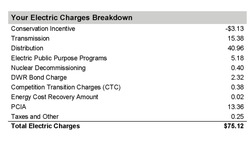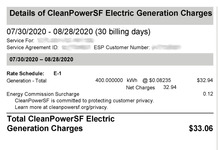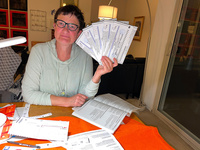 |
| Angelika/Mike Schilli |
|
|
|
Michael You in Germany have been taken pretty much to task lately when it comes to household costs for electricity and gas. Let's compare: How much do citizens in America pay for energy supply for their private households? To make a long story short, we paid 108 dollars for 400 kilowatt hours in September, that's about 27 cents per kilowatt hour. But, as you can imagine, electricity prices vary greatly by state, our informant in Florida recently told us that he paid only 133 dollars for 811 kWh there, almost half, 14 cents per kWh.
As already discussed in a previous issue (Rundbrief 05/2017), our electricity in the San Francisco Bay Area comes from a private company called PG&E, or "Pacific Gas and Electric", which has a monopoly on electricity within several hundred kilometers. Now PG&E is a pretty shady company that keeps slipping from one crisis to another. Their power lines spark and cause forest fires, and so PG&E sometimes just shuts off the power in rural areas with lots of trees during the summer. PG&E runs such outdated and totally dilapidated infrastructure that it can't meet the energy needs of the Bay Area. When everyone turns on their appliances, it all collapses. This is evident in the summer when the residents of the hot Silicon Valley cool their apartments with air conditioners all day. The supply breaks down and entire districts remain without electricity for days. As a precaution, PG&E simply turns off the electricity in some cities in the Silicon Valley in rotation with so-called "Rotating Outages". Just imagine, someone lives right next to the historic spot where the iPhone was invented and has no electricity for days, like in the third world. Of course, able bodied citizens like ourselves can live without air conditioning for a few days, but when the food in the refrigerator and freezer starts rotting, the fun is over.
PG&E encourages people to use less electricity so that the capacity for both large and small consumers is sufficient. As possibly the only private company in the world, PG&E even advertises for consumers to buy less of their product, electricity! For this reason, they introduced tiered pricing. Those who consume more than the average pay higher kilowatt prices. We consume slightly more than the average household and have made a deal that the electricity mix comes partly from renewable energy and we pay, on average, about 27 cents per kilowatt hour. How does this break down exactly?
In Figure 3 you can see that we have consumed exactly 400 kWh in the example month, of which the electricity delivery (Delivery) for the first 225 kWh costs 24 cents/kWh and the remaining 175 kWh costs 30 cents/kWh. PG&E then deducts the "Generation Credit" of 47.01 dollars, but adds the "Power Charge Indifference Adjustment" and 25 cents "Franchise Fee Surcharge". The table "Your Electric Charges Breakdown" (Figure 4) tries to explain how these 75.12 dollars are composed, with all kinds of individual items that nobody understands. You also might be rightfully scratching your head over the fact that the amount was previously determined per kWh and here there are just fixed costs. Later, the generation fee ("Generation Charge") is added, which amounts to 32.94 dollars with 400 kWh (Figure 5). Less the previously deducted "Generation Credit", mind you. In short: Nobody understands how the costs are composed, you just pay what is printed on the bill.
We pay the monthly electricity bill not by direct debit, but traditionally by hand. Until a few years ago, Angelika opened the paper bill sent to us by PG&E by post, took out the checkbook and issued a check for the required amount, signed it, and sent it to PG&E in an envelope by post. At some point I found out that you can also transfer the amount by mobile app, and since then I have been responsible for doing this diligently every month.
Since electricity apparently is not just any commodity, but a necessity without which nobody can live, PG&E does not simply cut off the electricity if one fails to pay a bill. I found this out by accident, because at one time when I paid the bill, I made a mistake and only paid the "Delivery Charges" instead of the higher total amount. The lights stayed on! A month later, the next bill arrived and the missing amount had been added without comment. Muttering apologies under my breath, I paid as requested.
Lately, the cost of electricity at our place even varies according to the time of day. According to the Table of the electricity provider, we pay higher kilowatt prices between 4:00 pm and 9:00 pm than during the rest of the day. That is probably the time window when many people in San Francisco turn on the stove to cook dinner. If you want to save, you have to wait after 9:00 pm or to cook charge the Tesla!

















